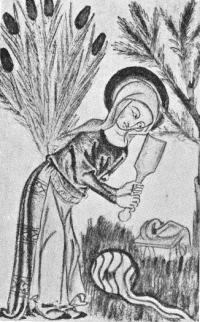 Those dirty clothes really pile up, don’t they? Especially when you have kids. As much as I grumble about having to wash and fold, I’m not really doing the work—the washing machine is taking care of the hard part for me. Our medieval counterparts certainly didn’t have that luxury, or many others that we don’t give much thought to. So in honor of my growing laundry pile, I thought today’s post would answer the question of “how would I have done it back then.”
Those dirty clothes really pile up, don’t they? Especially when you have kids. As much as I grumble about having to wash and fold, I’m not really doing the work—the washing machine is taking care of the hard part for me. Our medieval counterparts certainly didn’t have that luxury, or many others that we don’t give much thought to. So in honor of my growing laundry pile, I thought today’s post would answer the question of “how would I have done it back then.”
Laundry was unquestionably women’s work. Some cities had communal wash houses, where women could come to share news and gossip while they worked. Soapwort, an herb with cleansing properties, was sometimes used to get fabric clean. It was also beaten with “beetles”, rinsed, and wrung. Marjoram could be used to give washing water a pleasant scent. Clothing could also be washed in natural bodies of water (rivers, streams, ponds), and beaten against rocks.
 If one needed to remove stains, this could be done with the use of Fuller’s Earth or ashes soaked in lye. The mixture would be applied to the stain, allowed to try, then rubbed off. For more delicate materials, such as silk, verjuice was another remedy. Removing stains such as oil or grease was a more complex process. One recipe is as follows: “To remove grease or oil stains, take urine and heat until warm. Soak the stain for two days. Without twisting the fabric, squeeze the afflicted area, then rinse. As an alternative for stubborn greasy or oily stains, soak in urine with ox gall beaten into it, for two days and squeeze without twisting before rinsing.” White cloth could be cleaned and brightened by soaking it in lye, which was mixed using ashes and urine.
If one needed to remove stains, this could be done with the use of Fuller’s Earth or ashes soaked in lye. The mixture would be applied to the stain, allowed to try, then rubbed off. For more delicate materials, such as silk, verjuice was another remedy. Removing stains such as oil or grease was a more complex process. One recipe is as follows: “To remove grease or oil stains, take urine and heat until warm. Soak the stain for two days. Without twisting the fabric, squeeze the afflicted area, then rinse. As an alternative for stubborn greasy or oily stains, soak in urine with ox gall beaten into it, for two days and squeeze without twisting before rinsing.” White cloth could be cleaned and brightened by soaking it in lye, which was mixed using ashes and urine.
Undergarments were washed fairly often, even if they were only rinsed out at home in warm water, but woolen outer garments were rarely washed. They would have simply been shaken or beaten with a brush or a bundle of twigs to get rid of dust and dirt. Robes and cloaks might be rubbed with wax to weatherproof them, but this process would have been too expensive for peasants who would have worn felted wool instead.
Washed clothing was dried outdoors; laid across bushes, flat on grass, or draped across wooden frames or ropes. These of these could be moved indoors during poor weather if there was enough space.
Use the Medieval Monday Index to discover more topics relating to daily life in the Middle Ages.
Reblogged this on Chris The Story Reading Ape's Blog.
LikeLike
Thanks, Allison, for another interesting post. 🙂 — Suzanne
LikeLiked by 1 person
Plenty of uses for urine in the old days, and now we just flush it away. 😀
LikeLiked by 3 people
I am so thankful I am not a woman in those times. Then again I am also thankful I am not a man in those times. Both genders worked way too hard just to survive. Thanks for making me appreciate my appliances and the power to run them. Hugs
LikeLiked by 1 person